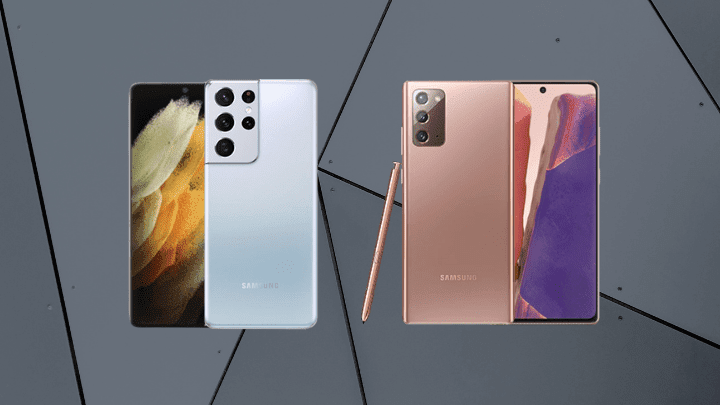Samsung has recently introduced the Galaxy S21 Ultra, and, in the premiere, it is compatible with the S Pen, even if the S Pen itself won’t be bundled with the phone like it is on the Note devices.
That made many potential customers wonder if they should buy the Galaxy S21 Ultra instead of the Note 20 Ultra if they are looking for the pinnacle of what Samsung can offer.
Let’s analyze the advantages of the Galaxy S21 Ultra over what the Note 20 Ultra offers.
Both are big devices, and the core difference between them is design. The Note has a very familiar rectangular shape with sharp corners that aren’t like any other phones, and it is a bit wider than a regular device. Simultaneously, the S21 Ultra distinguishes itself with a slightly narrower shape with minimalist, rounded corners. On the other hand, the S21 Ultra packs a new camera styling that sort of blends with the device’s metal margins, making it look very stylish. The S21 Ultra is also somewhat thicker – just thick enough. One would feel the difference in thickness after holding both devices.
The S Pen compatibility will likely get more creative people convinced to buy the S21 Ultra. The S Pen, on the other hand, won’t reside inside the phone’s body. It will be available for purchase separately or will be featured in specific packs.
Neither of the two devices has a headphone jack, and Samsung went even further with the S21 Ultra by removing the microSD card slot, a feature that was specific to the lineup.
The Note 20 Ultra also packs a slightly bigger screen size. On paper, the difference results in only 0.1 inches, but, as the Note is wider, it actually packs a significantly larger screen area.
When it comes to displays, the resolution and actual size are the only parameters that differentiate the two devices. The S21 Ultra has a 1440 x 3200 pixels resolution, at 516 PPI, while the Note 20 Ultra has a 1440 x 3088 pixels, at 496 PPI. For daily usage, they are virtually the same.
However, the S21 Ultra is newer, and it benefits from some new technologies. It features the highest brightness peak of any smartphones (it can reach 1,500 nits when needed), so you can easily use it even under summer sunlight, and its colour output will likely be better as well.
Both devices can support QHD resolution for intense details, but, curiously, the Note can’t use the 120Hz Dynamic, fast refresh rate at peak resolution, while the S21 Ultra has that option. The 120Hz refresh rate is variable on both devices, which means that it only gets activated when needed, while the rest of the time, the devices run at a lesser refresh rate to decrease power consumption and prolong battery life.
Besides the more refined LTPO display tech and the significantly more granular dynamic refresh rate, the Galaxy S21 Ultra display is superior to the one featured on the Note 20 Ultra in most ways.
The S21 can muster significantly higher peak brightness in everyday usage, which is particularly advantageous when outdoors, in contrast to the Note 20 Ultra.
Finally, the S21 Ultra has the more colour-correct screen, as seen from Delta E analysis run by experts.
When it comes to comparing the two displays side to side, the S Pen stylus digitizer support on the S21 Ultra is very convenient. However, there is an additional advantage – the under-display finger scanner with a greater detectable area than that of the Note’s, overpassing it in speed and responsiveness of biometrical unlocks. The Galaxy S21 is superior in terms of display features. No doubt why it beats any other popular smartphones of the moment.
The Galaxy S21 Ultra is available with the newest and most advanced chip from Qualcomm, the new Snapdragon 888, compared to an old-gen Snapdragon 865+ used on the Note 20 Ultra.
The fresher Snapdragon 888 chip marks a significant step forward in performance due to the more advanced 5nm manufacturing process used that allows for more transistors and increased performance without much of an increase of power consumption. It’s not like the Note 20 Ultra is slow, but the S21 Ultra is definitely superior.
Both devices come with a base storage of 128GB in the United States, a reasonable quantity, but only the Note has the option to expand storage via microSD card. The S21 Ultra is the first Samsung flagship device that doesn’t pack a microSD slot. The disadvantage is compensated by the two options with extra storage – 256 and 512 gigabytes. When you look at it, Samsung did precisely what Apple did with its iPhones in terms of storage.
As for 5G connectivity, both devices are compatible with all of the 5G bands currently available (UWB on Verizon or mmWave), but the S21 Ultra has a built-in 5G modem, which makes it use less energy in the long run.
One of the main selling points of Samsung flagships is camera quality. The Note 20 Ultra impressed most people with the camera’s fantastic styling, including the metal rings around the lenses, plus the extra stylish look. But when it comes to actual camera performance, the S21 Ultra breaks the limits. In 2020, Samsung introduced the 100X Space Zoom feature on the S20 Ultra, but many people complained that the pictures they took with more than 50X zoom were barely usable. Samsung listened to those complaints and cut back on the Note 20 Ultra capabilities, which now features zoom only up to 50X.
However, the 100X zoom feature is back with the S21 Ultra, but this time it has better quality.
The S21 Ultra can bring that feature back thanks to a new, 10X zoom native periscope lens, the most advanced zoom ever used on a Galaxy device, and it uses the camera combined with enhanced digital zoom to reach 100X.
Samsung included a secondary, 3X zoom telephoto lens, too.
Both telephoto devices feature optical image stabilization, which is imperative to achieving clear images at longer zoom ranges. All of that turns the S21 Ultra into the ultimate zoom camera phone.
Another peculiar modification is in the central camera unit, which is now significantly wider on the S21 Ultra – it can shoot at 24mm instead of the standard across most devices of 26mmlength. Though that may sound like an insignificant difference, it will make a much different perspective on images taken with the primary camera.
However, that difference will likely be detectable by eagle-eyed viewers.
We are pleasantly surprised by the improvements in low-light images.
The S21 Ultra features laser auto-focusing systems that help relieve the focusing problems that used to haunt the S20 Ultra. It can also record 8K video at 24fps, with the possibility of capturing high-quality screen grabs straight from the footage, so you don’t have to switch between photo and video.
All in all, both devices are excellent. The choice is yours – Will you opt for the latest technologies and pay the price or will you go with an older, yet still capable model?













Leave a Reply